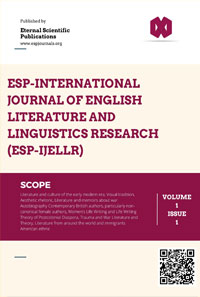ESP International Journal of English Literature and Linguistics Research (ESP-IJELLR)
Citation :
Gokul G, Rengaraj, 2025. "The Role of Slang, Jargon, and Sociolects in Urban Youth Identity" ESP-International Journal of English Literature and Linguistics Research (ESP- IJELLR) Volume 3, Issue 2: 16-23.
Abstract :
Language is a primary resource for people when constructing, negotiating and expressing their social identities; it does more than convey of meaning. Specialized language use such as slang, jargon and sociolects represent most noticeable linguistic means that the urban youth employ a lot for cultural positioning, affiliations to peer group and identity formation. Being as slang is informal and often fleeting, it’s a means of creative expression for young people — without it they cannot easily show off their individuality while still demonstrating that they are part of the group. Arising within heterogenous affinity groups and substructures, jargon mirrors common attitudes, activities and understanding of specific social areas, enabling more expedited forms of communication among those they apply crossing official language boundaries. One of these sociolects, as regions et the ne new youth identities Bewertungen zips as 2001;) schü Developmental science has to do with urban youth being characteristics (difrogger v2.0 widening-access spit for printer friendly version Introduction Such speech styles can be an even better indicator of urban youth identity, taking into consideration such factors like age, race, class and regiona.Taking a social, cultural and performative approach to the analysis of multilocality, this research explores how slang, jargon and sociolect affect urban teenagers' identities. The research is based on a mixed-method methodology: qualitative interviews; discourse analysis of online and off-line communication; and a quantitative survey of 200 urban teenagers. Such language patterns are, the research claims, both expressions of identity and strategies for social bonding, agency and resistance. Slang is rapid changing and serves as a medium for trial and error as well as creativityas itis often influenced by the media, popular culture, interaction with peers. Jargon is a way of life, and essential for community-building (huge particularly online/in internet subcultures). Sociolects, however, are indicative of peer-group norms and local urban culture fixing the identity with youth language across social contexts.The findings show the dynamic relationship between language, culture and society in urban areas. Urban youth language, the study says, is a performative social practice which allows young people to navigate issues of (dis)identity, solidarity and power in these quickly changing cultures. And on top of that, social media and digital communication dramatically accelerate the propagation and mutation of slang and jargon, turning us all into flexible, context-driven language machines. Greater inclusion of youth voices in academic and social discussion, greater sociolinguistic understanding of urban youth cultures, as well as more informed educational practices and policy frameworks are all enabled by recognizing the significance of these vernacular practices.
References :
[1] Androutsopoulos, J. (2014). Networked multilingualism: Some language practices on Facebook and Instagram. International Journal of Bilingualism, 18(4), 461–480.
[2] Bucholtz, M. (2003). Sociolinguistic nostalgia and the authentication of identity. Journal of Sociolinguistics, 7(3), 398–416.
[3] Cameron, D. (2003). Gender and language ideologies in the construction of teenage peer groups. Language in Society, 32(3), 337–364.
[4] Chambers, J. K., & Trudgill, P. (1998). Dialectology. Cambridge University Press.
[5] Crystal, D. (2003). A Dictionary of Linguistics and Phonetics. Blackwell Publishing.
[6] Eckert, P. (2000). Linguistic Variation as Social Practice. Blackwell.
[7] Eble, C. (1996). Slang and Sociability: In-group Language Among College Students. University of North Carolina Press.
[8] Heller, M. (2007). Bilingualism: A Social Approach. Palgrave Macmillan.
[9] Labov, W. (1972). Sociolinguistic Patterns. University of Pennsylvania Press.
[10] Sperber, D., & Wilson, D. (1995). Relevance: Communication and Cognition. Blackwell.
[11] Milroy, L., & Milroy, J. (1992). Social Network and Social Class: Toward an Integrated Sociolinguistic Model. Language in Society, 21(1), 1–26.
[12] Tagliamonte, S. (2016). Teen Talk: The Language of Adolescents. Cambridge University Press.
[13] Green, L. (2002). African American English: A Linguistic Introduction. Cambridge University Press.
[14] Bell, A. (2001). Back in style: Reworking indexicality in sociolinguistics. In P. Eckert & J. Rickford (Eds.), Style and Sociolinguistic Variation.
[15] Milroy, J. (1980). Language and Social Networks. Basil Blackwell.
[16] Labov, W. (2006). The Social Stratification of English in New York City. Cambridge University Press.
[17] Kerswill, P. (2002). Koineization and Accommodation. In J. Cheshire (Ed.), English Around the World.
[18] Androutsopoulos, J., & Georgakopoulou, A. (2003). Discourse constructions of youth identities. Journal of Sociolinguistics, 7(4), 465–484.
[19] Eckert, P., & McConnell-Ginet, S. (2013). Language and Gender. Cambridge University Press.
[20] Holmes, J. (2013). An Introduction to Sociolinguistics. Routledge.
Keywords :
Slang, Jargon, Sociolects, Urban Youth, Identity Construction, Peer Groups, Sociolinguistics, Cultural Expression, Digital Communication, Social Stratification.


 :10.56472/25842773/IJELLR-V3I2P103
:10.56472/25842773/IJELLR-V3I2P103